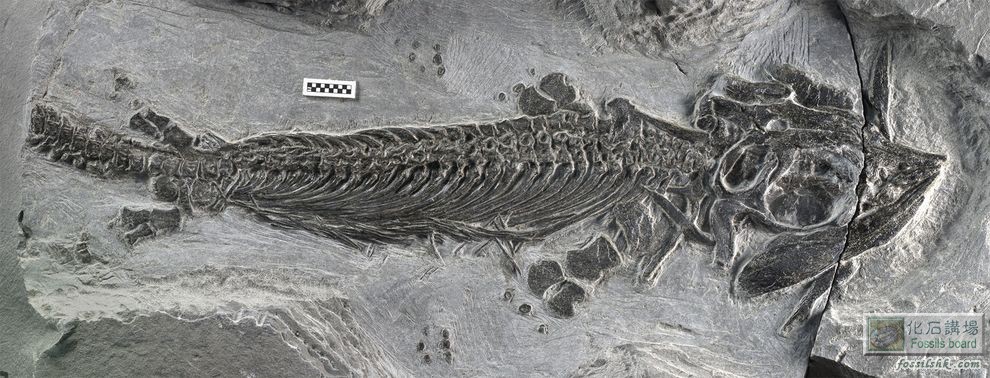fossilshk
(Lung)
管理員
  








UID 1
精華
22
積分 4509
帖子 2705
閱讀權限 200
註冊 2006-7-14
來自 中國/香港
狀態 離線
|
[廣告]:
First Amphibious "Sea Monster" Found; Fills Evolutionary Gap
By Christine Dell'Amore
National Geographic
Published November 5, 2014
A new species of dinosaur-era sea reptile that could live on both land and in water has been unearthed in China—the first amphibious "sea monster" ever found.
 圖片附件: amphibious-icthyosaur.jpg (2014-11-6 03:29 PM, 163.96 K) 圖片附件: amphibious-icthyosaur.jpg (2014-11-6 03:29 PM, 163.96 K)

A fossil of the newfound ichthyosaur, Cartorhynchus lenticarpus, shows the creature was built for land and sea.
The ichthyosaur, whose discovery was announced Wednesday, fills a crucial gap in the evolution of these dolphin-like predators, which thrived in Jurassic seas about 200 million to 145 million years ago. The reptiles could grow to 65 feet (20 meters) in length, about as long as a tractor-trailer.
Scientists knew that ichthyosaurs evolved from land to the sea, since they have found fossils of both land-dwelling ancestors and the fast-swimming marine creatures—sometimes nicknamed "sea monsters."
So paleontologists suspected there must be some in-between ichthyosaurs out there. For instance, both whales and plesiosaurs, another type of ancient marine reptile, made the move from land to sea, and scientists have unearthed fossils of amphibious species that show that transition. (Explore an interactive sea-monster timeline.)
Recently, scientists excavating a site in Anhui Province (map) found the specimen they'd long sought: a fossil from a 1.5-foot-long (0.5 meter) animal that lived 248 million years ago, during the early Triassic period.
With a short snout, heavy build, and unusually large flippers, the newfound Cartorhynchus lenticarpus was built for both land and sea, researchers report in the journal Nature.
"An amphibious animal was somehow missing from the ichthyosaur record, and this animal fits that picture very nicely," said study leader Ryosuke Motani of the University of California, Davis, an expert on prehistoric marine reptiles.
Fish Out of Water
The newly discovered species may have evaded paleontologists simply because people haven't dug into enough early Triassic deposits, speculated Motani, whose work was funded by the National Geographic Society's Committee for Research and Exploration.
In fact, Motani wasn't sure what he had at first: "When I first saw the animal, I was really puzzled." (See "New Sea Monster Found, Rewrites Evolution?")
Eventually, Motani and colleagues pieced together a bottom dweller with unique adaptations for amphibious life.
Its flexible, seal-like flippers and wrists allowed it to crawl on land, and its stubby limbs and thick rib bones gave it power to swim through rough waves along the coast.
Cartorhynchus also had a very short snout, inherited from its land ancestor, that was very different from the long noses of later ichthyosaurs, which allowed them to capture fast-moving prey like fish and squid, Motani said.
Based on its body shape and large flippers, the new species probably wasn't a fast swimmer, instead rooting around for bottom-dwelling creatures like shrimp in what was then a tropical archipelago, Motani speculated.
Valentin Fischer, a geologist and paleontologist at the Royal Belgian Institute of Natural Sciences, agreed by email that Cartorhynchus wasn't a good swimmer, especially since large and flexible flippers are less efficient than smaller, stiffer flippers.
Ichthyosaurs probably relied on their tails for swimming, said Fischer, who wasn't involved in the study. Since "the tail is not preserved on Cartorhynchus ... the complete picture of its swimming abilities is still to be revealed."
In addition, the new species' skull anatomy suggests it was a suction feeder, basically vacuuming up soft-bodied prey. A lack of fossilized prey near the specimen supports this theory, since soft-bodied animals aren't preserved in rock.
Overall, the evidence of suction feeding, shortened hind limbs, and thickened ribs are all "convincing" evidence that Cartorhynchus was amphibious, he noted. (Get more sea-monster fun facts.)
"By all means, this specimen is indeed very distinct from any ichthyosaur I have seen."
Bouncing Back
The new fossil also helps show what happened to ichthyosaurs after the Permian-Triassic mass extinction 252 million years ago, in which more than 90 percent of marine species died out.
Scientists have long wanted to know how long it took for animals and plants to bounce back after that catastrophic die-off.
Cartorhynchus's discovery shows it took ichthyosaurs four million years to reemerge in China before rapidly spreading worldwide. (Read "When Monsters Ruled the Deep" in National Geographic magazine.)
"This opens many new research avenues," Fischer noted, "notably to understand: Why was that part of the world special for marine reptiles?"
| 
 |
|





